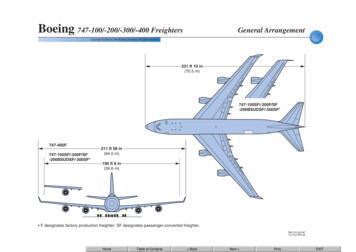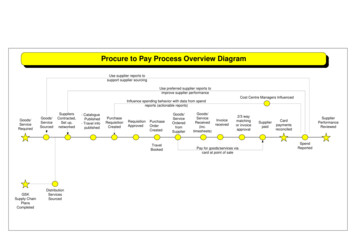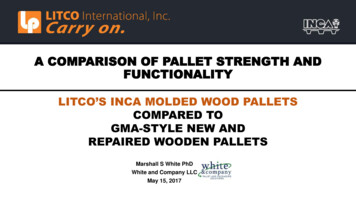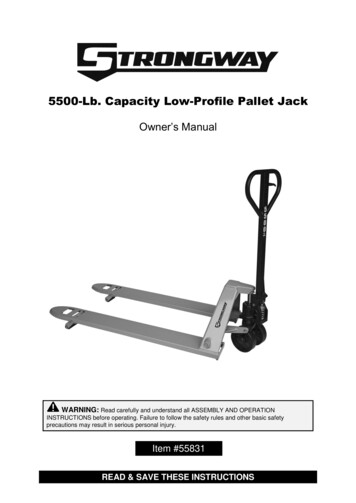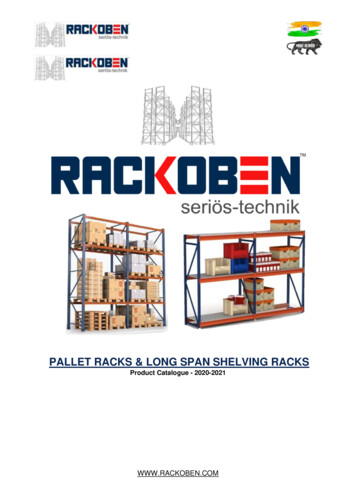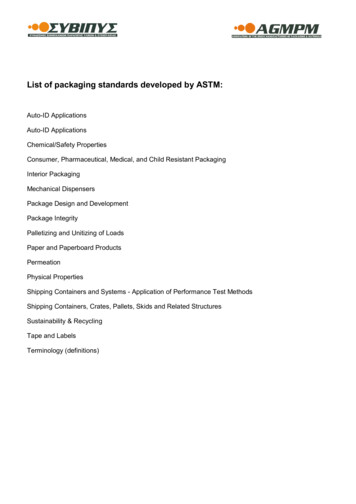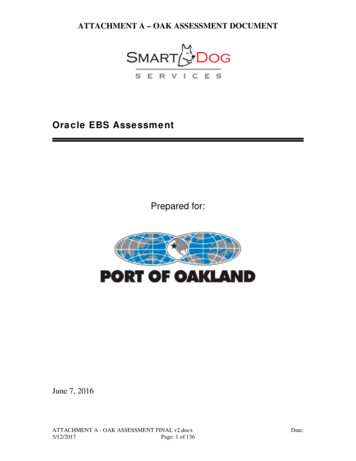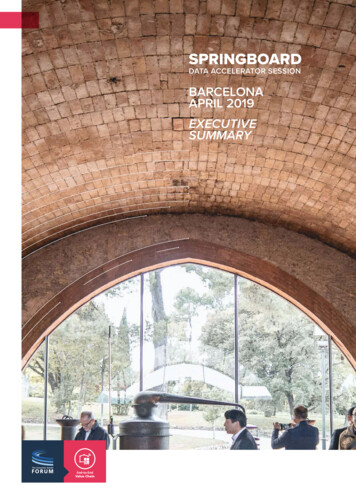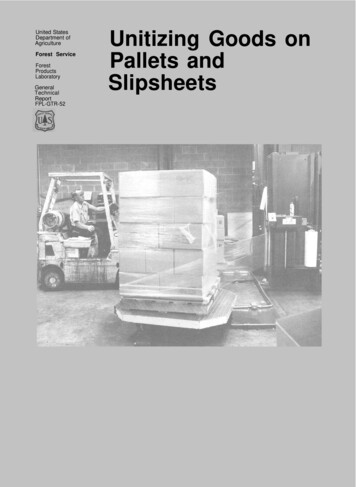
Transcription
United StatesDepartment ofAgricultureForest ortFPL-GTR-52Unitizing Goods onPallets andSlipsheets
AbstractAcknowledgmentsPackaging, handling, and shipping methods and facilitieshave changed drastically since World War II. Today, mostproducts are individually packaged and then combined intounitized loads for more efficient handling, storage, andshipping. The purpose of this manual is to promote the mosteffective use of wood and wood fiber in current packagingand shipping practices by providing a basic understanding ofthe many factors involved in selecting an optimal method ofunitizing goods on pallets and slipsheets. The manual alsoprovides a valuable place of reference for the numerousstandards and specifications relating to unitizing loads.The figures in this manual are adapted from a variety ofsources. They are as follows:Keywords: Unitizing, palletizing, pallets, slipsheets,strapping, shrinkwrap, stretchwrap, netwrap, adhesives, hotmelts, material handling, 1November 1986Laundrie, James F. Unitizing goods on pallets and slipsheets.Gen. Tech. Rep. FPL-GTR-52. Madison, WI: U.S. Department ofAgriculture, Forest Service, Forest Products Laboratory; 1986. 45 pA limited number of free copies of this publication are available to the publicfrom the Forest Products Laboratory, One Gifford Pinchot Drive, Madison, WI53705-2398. Laboratory publications are sent to over 1,000 libraries in theUnited States and elsewhere.The Laboratory is maintained in cooperation with the University of Wisconsin.Based on information provided by:Forest Products LaboratoryA-B-C Packaging Machine CorporationMaterial Handling Engineering MagazineSignode CorporationMobile Chemical CompanyLantech IncorporatedCTX Products CompanyGloucester Engineering CompanyRadiant Engineering CompanyCTX Products CompanyMalow Corporation and Trident ManufacturingCompanyPresto Products IncorporatedMIMA CorporationLantech CorporationAktron CorporationBemis Company and Conwed CompanyNational Wood Pallet & Container Association,Virginia Polytechnic Institute and StateUniversity, and Forest Products LaboratoryInca Presswood Pallets LimitedElberta Crate & Box Co.Menasha CorporationSt. Regis Paper Co.Michigan Technological UniversityAmoco Engineered Plastics Co. and MenashaCorporationBanner Metals Co.Eaton CorporationRack Manufacturers InstituteAmerican National Standards institute,Committee MH1Clark Equipment CompanyHyster CompanyEaton CorporationClark Equipment Co.
Unitizing Goods onPallets andSlipsheetsJames F. Laundrie, Chemical EngineerForest Products Laboratory, Madison, WI
PrefaceThis manual presents information necessary for anunderstanding of the factors involved in choosing an optimalmethod of unitizing goods on pallets and slipsheets.Unitizing is the process of combining individually packagedproducts into a larger, stable, unit load convenient forhandling, shipping, and storage. Whatever packagingmethod is used-single containers (“break-bulk”) or bulkpackaging or unitizing-the shipper has to choose from avariety of handling and shipping methods and transportvehicles: these are considerations that face all who mustdecide how products are to be packaged for shipment. Here,the options are presented for the packaging and shipping ofunitized loads.Why Unitize?Whenever practical, individual products are combined andshipped as larger unitized loads. Unitizing has significantadvantages. The cost of labor arising from manual handlingis reduced appreciably by use of mechanical equipmenthandling larger unitized loads. Required shipping time andlosses by pilferage are reduced. Moreover, unitized handlingequipment produces a mechanically milder shippingenvironment, so that the goods generally need lessprotection enroute to their destination. The last point will bebetter appreciated by considering the common hazards ofpackages in the shipping environment.Shipping EnvironmentSome of the most common hazards to goods being shippedare:lllllShock and vibration that occurs within the factory, duringtransportation to the distribution warehouse by truck, rail,air, or barge, during humping operations intrain-marshalling yards, when trucking from distributionwarehouses to consumer. and during shipment overseasby ship or air;Accidental impacts during manual and mechanicalhandling operations, including dropping flatwise,edgewise, and cornerwise at various stages during itsdistribution;Compressive forces caused by stacking in storage and intransport vehicles;Creep and a resulting looseness from compressive forces;Temperature and moisture extremes in storage andtransportation.Definition of the shipping environment has been slowbecause of its complex and changing nature. The mostcomprehensive analysis of the current shipping environmentwas prepared by Ostrem and Godshall (1979).Purpose and Use of This ManualThe main purpose of this manual is to provide a basicunderstanding of factors that must be weighed in choosingan optimal method of unitizing goods on pallets andslipsheets. These factors are many and, in most situations, avariety of persons are eventually involved in making thedecision how a load is to be unitized.Part I deals with major considerations in the preparation ofthe unit load. Discussion includes questions of standards forstacking a load; unitizing equipment, and the several waysto stabilize the load: by antiskid treatment to diminish themovement of its parts, or by strapping, shrink wrapping, orstretch wrapping or netting to restrain the load. Whenunitized, the load should be compatable with the storage,handling, and shipping facilities by which it is sent to itsdestination. Shipping cost must, of course, be kept to aminimum, and a number of the factors discussed bear onthe total cost of shipment. Moreover, the level of productionand the nature of the loads may justify more or less newinvestment in equipment to reduce overall cost and improvethe system.Most often unitization involves the use of wood pallets orwood-derived slipsheets as bases for the unitized load.Part II, therefore, is devoted to a discussion of pallets andslipsheets. It covers the classification by use of wood pallets,description of a variety of designs, and consideration of theproperties intrinsic to the wood or resulting from how thewood members were prepared and the pallets constructed.Common defects and restrictions on substandard pallets arenoted. Sometimes, nonwood pallets or slipsheets aredesirable, end these also are discussed, to extend theusefulness of the, manual as a guide to the use of all thematerials employed in unit-load preparation.The manual contains sufficient information to provide only ageneral understanding of the factors involved in choosing anoptimal unitizing method. To learn the specific requirementsfor individual products and situations, of which a wide varietyexist, copies of the standards and specifications listed inAppendix B should be obtained from the issuingorganizations.Because every product and every situation is different, it isrecommended that packaging, material-handling,warehousing, distribution, and marketing personnel shouldwork together carefully to analyze the internal situation ofthe particular producer with regard to the method ofunitization, and then work closely with outside materialsuppliers, equipment manufacturers, and the transportindustry.iii
ContentsPagePreface . . . . . . . . . . . . . . . . . . . . . . . . . . . . . . . . . . . . . . . .Why Unitize? . . . . . . . . . . . . . . . . . . . . . . . . . . . . . . . . .Shipping Environment . . . . . . . . . . . . . . . . . . . . . . . . .Purpose and Use of This Manual . . . . . . . . . . . . . . .Part I: Unit-Load PreparationIntroduction . . . . . . . . . . . . . . . . . . . . . . . . . . . . . . . . . . . .Stacking on Pallets and Slipsheets . . . . . . . . . . . . . . . .Standards for Stacking a Unit Load . . . . . . . . . . . . .Unitizing Machines . . . . . . . . . . . . . . . . . . . . . . . . . . . .Load Stabilization . . . . . . . . . . . . . . . . . . . . . . . . . . . . . . .Antiskid Treatment . . . . . . . . . . . . . . . . . . . . . . . . . . . .Strapping . . . . . . . . . . . . . . . . . . . . . . . . . . . . . . . . . . . .Shrink Wrapping .Stretch Wrapping . . . . . . . . . . . . . . . . . . . . . . . . . . . . .Stretch Netting . . . . . . . . . . . . . . . . . . . . . . . . . . . . . . . .Part II: Pallets and SlipsheetsIntroduction . . . . . . . . . . . . . . . . . . . . . . . . . . . . . . . . . . . .Pallets . . . . . . . . . . . . . . . . . . . . . . . . . . . . . . . . . . . . . . . . .Lumber Pallets . . . . . . . . . . . . . . . . . . . . . . . . . . . . . . .Pallet Wood Members . . . . . . . . . . . . . . . . . . . . . . . . .Pallet Fasteners . . . . . . . . . . . . . . . . . . . . . . . . . . . . . .Nonlumber Pallets . . . . . . . . . . . . . . . . . . . . . . . . . . . .Pallet-Handling Equipment . . . . . . . . . . . . . . . . . . . . .Slipsheets . . . . . . . . . . . . . . . . . . . . . . . . . . . . . . . . . . . . . .Materials . . . . . . . . . . . . . . . . . . . . . . . . . . . . . . . . . . . . .Slipsheet-Handling Equipment . . . . . . . . . . . . . . . . . .Part III: AppendixesAppendix A-References . . . . . . . . . . . . . . . . . . . . . . . .Appendix B-Specifications and Test Methods . . . . .Appendix C-Specific Gravity and Modulusof Rupture . . . . . . . . . . . . . . . . . . . . . . . . . . . . . . . . . . . . 143
Part IUnit-LoadPreparationIntroductionStacking on Pallets and SlipsheetsBecause most products are shipped in corrugated fiberboardboxes of various designs, sizes, and shapes, the followingdiscussion is for the most part about the preparation of unitloads of corrugated fiberboard boxes. Unitized loads may, infact, consist of almost anything, from corrugated fiberboardboxes, sacks, bags, drums, pails, and trays to individualitems such as stoves, refrigerators, washing machines, andclothes dryers. Each of these types of container or productpresents its own peculiar unitization problems which are notcovered here.Standards for Stacking a Unit LoadThe essential steps in unitizing are, first, stacking the loadon pallets or slipsheets, and then stabilizing the load by oneof several methods. Antiskid or adhesive treatment may beapplied to prevent movement of individual parts of the load.Strapping may be attached around the load, using atensioner to tighten the strap and a seal (applied by crimp ornotch sealer) to secure it in place, or using a combinationtensioning-and-sealing tool. The load may be wrapped inshrink film and heat applied to shrink the film close aboutthe load, or it may be wrapped in stretch film or stretchnetting under tension so that it clings to the load. Eachpossibility is considered in what follows, together with Meequipment by which it may be accomplished.1A comprehensive standard has been developed toaccomplish on a modular basis the fining of the contentswithin the package, the packages within the unit load, andthe unit loads within the truck trailer, freight container, orrailroad boxcar. Five unit-load sizes are recommended inthis standard, and dimensions are expressed both as netunit-load sizes (NULS) and as plan-view sizes (PVS). Thedifference between PVS and NULS is usually 4 percent ofNULS and is the allowance made for stacking irregularityand storage bulge. Of the five unit-load sizes used in thisstandard, the 1,200 mm by 1,000 mm (47.24 in by 39.37 in)comes closest to matching the pallet sizes (1,219 mm by1,016 mm (48 in by 40 in) or 1,016 mm by 1,219 mm (40 inby 48 in) commonly used in the United States. The otherfour NULS are 1,100 mm (43.31 in) by either 1,320, 1,100,880, or 825 mm (51.97, 43.31, 34.65, or 32.48 in). The fiveunit-load sizes in this standard are termed “intermodal unitloads” because they fit not only the general purpose freightcontainer which is intermodal to ship, truck, and rail, but thedomestic closed-trailer truck and the domestic railroadboxcar.Extensive lists of package dimensions and stacking patternsare given in Appendixes C and D of this ANSI text.Alternative patterns are illustrated in many instances. Thechoice of pattern depends on the nature of the package andits contents, as well as the expected conditions oftransporting. stacking, and storage. Some of the morecommon patterns are shown in figure 1. When the contentsof the package carry the load, it is common to interlock forgreater stability during stacking. However, when the contentsof the package carry the load only partially or not at all,columnar stacking is used to provide full-edge support andthereby utilize the maximum potential compressive strengthof the package. Variables such as product volume andweight, vehicle door heights, interior heights, andload-carrying capacity, all influence unit-load heights. Thefollowing unit-load heights2 based on alternating loads havebeen selected to achieve maximum volume: 813, 1,041,1,092, 1,372, and 1,829 mm (32, 41, 43, 54, and 72 in).1The American National Standard for Unit-Load and Transport-Package SizesANSI MH 10.1M-1980 (Appendix B)2The American National Standard for Surface Vehicles—Unit-Load Heights forPalletized Loads, ANSI MH10.6M-1983 (Appendix B).
Figure 1.—Various case stacking patterns: A. Block, B. split Block, C. Brick, D. row, E. split row,F. pinwheel (nonvoid), and G. pinwheel (void). (M86 5116)This standard contains an extensive table for total interiorheights, ranging from 1,880 mm to 3,861 mm (74 in to152 in); these are subdivided into the standardized unit-loadheights to obtain the maximum percentage of total interiorheight utilization. Also contained in the appendix of thisstandard are average density of various cargos and averageweight of unit loads at various heights for these cargos.Unitizing MachinesThe oldest method of unitizing was simply to stack theboxes on a base (either a pallet or slipsheet), using handlabor. Semiautomatic unitizing machines were soondeveloped in response to the need for higher productivityand lower labor costs. Unitizing machines have beenimproved through the years so that today they are fullyautomatic and can handle either pallets or slipsheets oreven unitize without a base support. They haveprogrammable solid-state controls, have box-size andunit-load-size changeover capabilities, and can handle awide variety of stacking patterns and unit-load heights.For slower lines, semiautomatic unitizing machines areusually the most cost-effective. The range is wide: thesimplest models simply turn the load base to allow theoperators to stack cases without walking around the base:the most complex only require the operator to push casesinto the correct pattern, and the unitizer then lifts the layerand places it on the base. Automatic unitizers are made bymany manufacturers: an example (fig. 2) illustrates how onefunctions. The sealed cases are automatically fed in and areoriented to a preprogrammed pattern. When one row hasbeen formed, the cases move forward. The next row is2formed and moved forward, and so on until me layer iscomplete and the loading plate is filled. The completed layeris then lifted to the height of the existing stack and movedinto position just above the stack. The loading plate is thenretracted, and the cases are allowed to settle row by row ontop of the stack. The load is squared by a squaring barwhich also assures complete unloading of the loading plate.The loading plate then returns to its starting position whereanother accumulated load is ready.Automatic unitizers can be furnished with automaticdispensers of pallets or slipsheets and automatic dispensersof tier (tie) sheets. An automatic strapper can be built intothe machine or the unitized load may be sent to anotherstation where the load is strapped or shrink wrapped orstretch wrapped for load stabilization. Sometimes anadhesive applicator is mounted on the top of the feedconveyor line to apply an adhesive to each case just beforeunitizing. Unitizers are made with right- or left-hand infeedsand with discharges either to the right or left or at rightangles to the infeed.The speed of a unitizer is dictated by the number of casesper layer, the number of layers per load, and the type, size,and weight of the case being handled. High-speed linesusually have one unitizer on each line. Sometimes, onslower lines, one unitizer can serve two or more lines whensufficient conveyors, switches, stops, and electrical controlsare used along with tier and stacking patterns that can beaccommodated by the unitizer controls. While this reducesthe cost of the unitizing equipment, it increases the cost ofconveyors and storage space. In selecting a unitizer. it isbest to work directly with the manufacturers of this type ofequipment.
Figure 2.—Typical automatic unitizer and its operation: A. Layer forming. Sealed shipping casesfeed in and are oriented to the preprogrammed pattern. When one row is formed, the cases moveforward. The next row forms and moves forward, and so on until the layer is complete and theloading plate is filled. B. Lifting the layer. The layer is lifted to the height of the existing stack. Thefilled loading plate moves into position just above the stack. C. Depositing the layer. The loadingplate retracts, allowing the cases to settle, row by row onto the top of the stack. The load is squaredby a squaring bar which also assures complete unloading. The loading plate returns to startingposition where another accumulated load is ready. (M86 5117)3
Load StabilizationSeveral techniques are commonly used to minimize orprevent movement of the individual units making up aunitized load. Each offers advantages and disadvantages.Antiskid TreatmentMost unitized loads rely on friction between layers to resistslip; antiskid treatments simply increase the coefficient offriction between the packages. Antiskid treatment may beapplied to the packaging container material duringmanufacture or as an adhesive coating on the tilledcontainers.For corrugated boxes, friction materials suspended in watercan be deposited on the paperboard at the corrugator. Inksor varnishes with antiskid additives can be applied duringprinting. In all cases of surface treatment with antiskidmaterials, the improvement in the coefficient of friction islimited by the characteristics of the materials rather than bythe amount applied. Improvement is also limited becausedust or other contaminants, falling on the container prior tostacking, tend to reduce or eliminate the antiskid properties.Also, disturbance of the antiskid surface during shipping andhandling between manufacturer and end user has atendency to reduce the effectiveness of the preappliedantiskid treatment.A better approach is to apply an antiskid coating after thecontainers have been filled and sealed. Adhesives used asantiskid coating (cold glues or hotmelts) are known asbreakaway or soft seal, meaning they have significantlylower adhesive properties than similar materials used forpackage sealing. They resist shear forces but can be brokenaway by a pulling force.Cold glues may be applied by air- or airless-spray methodsor by extrusion. The amount of glue deposited on thepackage is critical. Too little adds an insufficient resistanceto slip. Too much may cause fiber tear. Also, because glueis usually spread over a wide area, the appearance of thepackage and sometimes its integrity may suffer substantially.Hotmelt adhesives are the newest method of adding antislipproperties to packages after sealing. A relatively smallamount of hotmelt can significantly improve resistance to slipand costs less than cold glue despite the higher unit price.‘Also, the possibility of package damage from fiber tear isminimized or eliminated.Hotmelt offers better performance than other adhesivesbecause it operates on different principles. It functions toincrease skid resistance two ways: first, the adhesive usedis relatively soft and tacky after it has cooled-it has a highcoefficient of friction. Second, hotmelt is deposited in a beadwhich has a significant height (4.2-6.3 mm (1/6-1/4 in))which makes a mechanical interlock where the meetingsurface is slightly deformed by the weight of the package.4The thickness of the bead also insures adhesive contacteven if the packages are somewhat uneven. Exact locationand length of beads are best determined by experimentationunder actual operating conditions. Short beads at fourcorners of boxes and single elongated beads across thecenter of bags (either longitudinally or crosswise) aregenerally best. When the hotmelts cool, they do not sealeach case to each other but provide enough friction only toprevent the cases from slipping in the stack.When corrugated boxes make up the load, applyinghotmett on the top two or three layers of a six-tier loadis usually adequate. Hotmelts are normally not appliedto the top tier.In automatic systems, a carton or bag is conveyed underone or more automatic guns triggered by a solenoid valve inresponse to a sensor located at the conveyor. Dependingupon the carton size, a pair of guns each firing a singlebead or multiple-cartridge automatic guns with suitablespacing are used to deposit the adhesive beads,The bead pattern is essentially a bead-gap-bead. Thesequence is activated by a sensing device and consists of atimed deposition of hotmelt. a delay (gap), and a secondtime-measured deposit.Strapping3Whereas antiskid treatment merely diminishes the tendencyof cases to slip in the stack, strapping provides a positivemeans of retaining cases in place.Strapping ToolsBy strapping with handtools, product retention can beachieved without a large capital expenditure for automaticequipment. The single most significant feature ofhand-strapping tools is their portability. Many use only handlabor and are low enough in cost for multiple sets to belocated throughout a plant or warehouse as needed.Handtools for tensioning and sealing straps come in avariety of styles and sizes for virtually all kinds of strap.Some are designed for light-duty applications, others formedium- or heavy-duty applications. Applying heavy steelstrapping with handtools is difficult but, if dictated by thesmall number of loads or the need for mobility, may be theonly way to do the job economically. A typicalhand-strapping sequence is shown in figure 3.Hand-strapping does not always mean low volumes. Oftenloads do not lend themselves to automatic strapping, but thenumber of loads may be large. In these circumstances,air-powered or electrically powered sealers or combinationtools are used.3The discussion on hand-strapping equipment is excerpted, with permission,from copyright of Material Handiling Engineering (1981).
Figure 3.—Typical hand-strapping sequence. A. Place strap (a) around the load. Press tensioninghandle (b) fully downwards, thus raising the back clamp (c). Slide strap between the front plateand the bottom section of cutter drum, and between the center plate and the back clamp (c).Leave approximately 3 inches of strap protruding from the front end of the tool. Release the tensionhandle (b). B. Slide the top strap (a) through the cutter slot (b), and the tensioning drum slot (c).C. Guiding the strap (a) and tool (b), ratchet the tensioning handle (c) forwards and backwards untilthe correct tension is achieved DO NOT pull the tensioning handle fully back against the gripholder (b). D. Place the grip handle (a) in the rest position and fit an open seal (b) over the top andbottom straps. (When using a closed seal, the seal must be placed on the strap before step A.)E. Open the crimp sealer (a) and crimp the seal by placing the jaws of the tool over the seal andpushing the handles together. F. Squeeze the tensioning handle (a) fully against the housing grip,thus cutting the strap at the seal. Open the clamp and slide the tool away from the strap.(ML86 5118)Fully automatic strapping equipment is also available. Thisequipment can be installed directly on the unitizer or usedseparately as the next station in the line. Various types ofautomatic strapping equipment (fig. 4) can be used to applyeither horizontal or vertical straps.Strap tensioners.—These fall into four categories: thefeed wheel, push, windlass, and special purpose types(fig. 5). The feed wheel type uses a knurled wheel to gripthe strap and move it through the seal before crimping. Thepush type is used for tensioning straps around irregularshapes and in applications where me load is notcompressible. The distinguishing feature of me push type isthat there is no base or shoe under the strap as with thefeed wheel or windlass types.The most basic type of strap tensioner is the windlass type(fig. 5B). A split capstan accepts the strap, and moving thetensioning ratchet lever turns the capstan to tension thestrap. If a buckle is used, as on soft nonmetallic strap, thetensioner simply pulls the strap through the buckle wherethe strap returning on itself holds it tight.Where steel strapping is used, the tensioner holds one endof the strap while tensioning the other by winding it aroundthe capstan or moving it between gripper bars. When thedesired tension is achieved, a metal seal is placed over thedouble thickness of strap, and a sealing tool is used tosecure the seal to the strap.5
Figure 4.—Automatic strapping equipment. A, B, C. Unitizing with horizontal straps; D, E, F.Unitizing with vertical straps. (ML86 5119)
Powered tensioners and sealers, still in the handtoolcategory, are used for continuous production in areas wherethe loads are not uniform or where the need is infrequent.They are also used where straps must be applied fast andwith greater tension or more uniformity than is usuallypossible with nonpowered handtools.Strapping MaterialsStrap.—There is great variety in both steel and nonmetallicstrapping. In steel strap, the range of widths is 9.6-50.8 mm(3/8-2 in) and the range of thicknesses is 1.6-2.5 mm(0.065-0.1 in). The strap may be wound in flat or ribbon coilsor in wide mill-wound coils. Lengths vary according to typeand thickness. Round-end, precut-to-length straps are alsoavailable with a tolerance of 12.7 mm ( 1/2 in).Figure 5.—Various hand-strapping tensioners:A. push type, B. windless type, C. feed wheel typeD. special purpose. (ML86 5120)Sealers for steel strapping.—Where metal seals areapplied to steel strapping, the action of the sealers is eitherto crimp or notch the seal. This sealing action may be singlenotch, single reverse notch, double notch, double reversenotch, single crimp, or double crimp. Each of these sealingactions is done with a different type of tool (e.g., fig. 6A andB), and more than one style of tool may be available foreach sealing action. Steel strap sealers are available forstrap widths 9.5-50.8 mm (3/8-2 in). Handle length is variedto give better lever action for the larger seals and heavierstraps and for notching instead of crimping.Steel strapping can be ordered with slightly curved edges toavoid snagging. Finishes for steel strap include low-frictioncoating, black-painted and waxed, black-painted and dry,waxed only, zinc-finished waxed, galvanized, or printedthroughout the length with a message.Nonmetallic strap comes in 6.3-15.9 mm (1/4-5/8 in) widthsin a variety of colors or printed with a message. Coils aremill-wound to about 5,486 m (18,000 ft) per coil and come indispenser boxes or with fiberboard cores ready to be placedin a permanent dispenser.Sealers for nonmetaltic strapping.—Nonmetallicstrapping ends are held by a crimped metal seal, a heatseal, or a wire or plastic buckle. Nonmetallic strap is usuallycrimp-sealed by flattening, the seal having a rough interiorsurface, or by placing waves in it so that the strap ispressed firmly against itself in a friction grip against the sealand facing-strap surfaces.Heat sealing of nonmetallic strap results when the sealer (orcombination tool) rubs the strap surfaces against each otherso that the friction causes heat and thus makes a seal. Thistype of friction seal can be removed easily by hand byturning the strap over and peeling off the back strap end.This kind of seal is only used in conjunction with specifictypes of strap. There are other kinds of heat sealers thatactually melt the strap.Combination tools.—Hand-powered combinationtensioning and seating tools (fig. 6C and D) use a leveraction to pull the strap tight and then another lever either tocrimp or notch the seal while the ends are held. Electricallypowered tensioners work in the same manner but usepowered knurled wheels to grip and tension the strap.Figure 6.—Examples of A. crimp sealer, B. notchsealer, C. D. combination tools for strapping.(ML86 5121)7
Nonmetallic strap may be of polypropylene, polyethylene,nylon, rayon cord, or one of several proprietary plasticcompositions. Each exhibits specific properties under tensionand ambient conditions, as well as in relation to the loadbeing secured.Buckles.— Buckles for hand tensioning and light windlasstensioning of flexible nonmetallic strap are made ofbent-tempered wire or molded plastic. Plastic buckles aresometimes easier to use because they thread more quicklythan their wire counterparts. Buckles are available fornonmetallic strap of widths: 6.3, 12.7, or 15.9 mm (1/4, 1/2,or 5/8 in). These are sometimes called self-sealing buckles.Seals.—There are many basic kinds of seals, namelysnap-on, open flange, push, thread-on. and open types formetallic strapping (fig. 7). and open seal, closed seal, doubleseal, combination tool seal, and heat seal for nonmetallicstrapping. Push-type seals (fig. 7A) are fully closed and thread ontothe strap before tensioning. They are used where strap istensioned by using a push-type tensioner. Snap-on seals (fig. 7B)
comes closest to matching the pallet sizes (1,219 mm by 1,016 mm (48 in by 40 in) or 1,016 mm by 1,219 mm (40 in by 48 in) commonly used in the United States. The other 880, or 825 mm (51.97, 43.31, 34.65, or 32.48 in). The five unit-load sizes in this standard are termed "intermodal unit loads" because they fit not only the general purpose .
